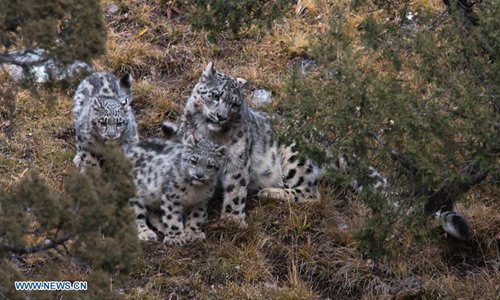
Photo taken on Oct. 22, 2017 shows snow leopards at Three-river-source National Park in northwest China's Qinghai Province. (Photo: Xinhua)
The number of rare wild animals like snow leopard and Tibetan antelope has increased notably in the Three-River-Source National Park in Northwest China's Qinghai Province, a demonstration of the achievements in the country's biodiversity conservation.
Wang Xiangguo, director of the park that is also known as Sanjiangyuan National Park, told the Xinhua News Agency that thanks to years of protection, the snow leopard population has exceeded 1,200.
The population of Tibetan antelope, once shrunk to less than 20,000 due to poaching, has now bounced back to more than 70,000.
The Sanjiangyuan National Park, with an average altitude of 4,712 meters and an area of 190,000 square kilometers, is the highest national park in the world.
Lying on the Qinghai-Xizang Plateau, it's home to the sources of three rivers - the Yangtze River, Yellow River and Lancang River. The winding mountains and snow peaks offer a perfect habitat for wild life under first-class national protection, such as snow leopards, leopards and Tibetan antelope.
Zhao Xinquan, a researcher with Qinghai University, said that the restoration of the snow leopard population in the park is made more remarkable against the backdrop of global biodiversity loss and accelerated species extinction.
Zhang Yujun, a professor with Beijing Forestry University, told the Global Times that the top-down approach in national park management played a vital role in restoring the rare animals' population.
One of the purposes of establishing the national park is to integrate existing protected areas and put them under unified management, which is more effective. Centered around a government-led mechanism, local residents and non-governmental organizations were mobilized in a joint effort to protect the endangered species, said Zhang.
"Households living around the park have engaged in patrolling and monitoring wild life. In addition, some NGOs have organized annual activities to raise the public's awareness of the park's biodiversity," Zhang said.
On Wednesday, a development plan for the Sanjiangyuan National Park (2023-30) was released by the Qinghai Provincial Government, detailing the paths to improve the protection and management system, monitoring and supervision platform, scientific and technological support and conservation of the park.
The plan stipulates that by 2025, vegetation coverage of the park will be increased steadily, and its ecosystem will be continuously reinforced.
The water quality of the Yangtze, Yellow, and Lancang rivers will be improved and the population of the endangered wild animals will see a steady growth in coordination with the development of the local community.
URL: https://www.seeglobalnews.com/read-2131.html